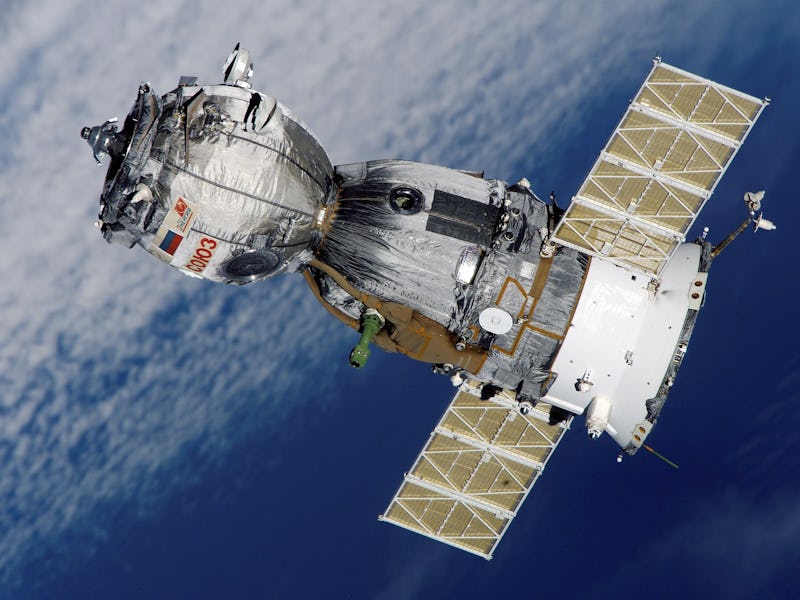Questions Over Soyuz Hole on ISS Mount as Russia Convenes Investigation
Meanwhile, NASA has stayed quiet on the matter.

Russia’s top space official casted doubt on Monday on the official reason the International Space Station lost air pressure last week, and by Tuesday, further questions surfaced over the cause of a hole in the Russia-made Soyuz capsule, which had to be patched up by astronauts 250 miles above the Earth.
Dimitry Rogozin, appointed as director of Roscosmos by President Vladimir Putin in May, first publicly considered that hole might be the result of sabotage:
“We are considering all the theories. The one about a meteorite impact has been rejected because the spaceship’s hull was evidently impacted from inside. However it is too early to say definitely what happened. But, it seems to be done by a faltering hand… it is a technological error by a specialist. It was done by a human hand — there are traces of a drill sliding along the surface. We don’t reject any theories,” he said.
Rogozin added, “It is a matter of honor for [Soyuz makers] Energia Rocket and Space Corporation to find the one responsible for that, to find out whether it was an accidental defect or a deliberate spoilage and where it was done - either on Earth or in space. Now it is essential to see the reason, to learn the name of the one responsible for that. And we will find out, without fail,” he pledged.
When asked for comments on the matter, a NASA official said that “Roscosmos has convened a State Commission to conduct further analysis of the possible cause of the leak” and referred Inverse to the Roscosmos press office.
The hole is in part of the capsule that isn’t used to carry astronauts back to Earth. Russia’s state-run media agency, TASS, reported on Tuesday that the capsule might have been damaged during terrestrial tests on the ground at the Baikonur Cosmodrome, Russia’s testing and launch site. The anonymous source speculated to TASS that an accidental drill hole might have been patched up during testing, but when the glue dried up in space, it fell out, and air pressure was lost.
Meanwhile, theories of the hole being caused in space seemed fade by Tuesday in Russia: “Why should any of the crew try to do that? I would not like to use the word nonsense, but all this does not fit in well with logic,” Russian rocket designer Alexander Zheleznyakov told TASS when asked if any of the ISS crew might have made the hole in the spacecraft’s hull. “Judging by what I saw on the photos, it must have been done on Earth. The hole is in a place that is very hard to get to. Drilling it would not be easy.”
In the early hours of Thursday morning, astronauts aboard the ISS awoke to learn that the orbiting lab and occasional badminton court was slowly losing pressure. Flight control in Houston and Moscow identified the issue on Wednesday evening, but they decided the leak was minimal enough that they allowed the crew to sleep through it. It was patched up the next morning.
A live feed from the ISS broadcasted a Houston ground control official commenting, “Right now Alex has got his finger on that hole and I don’t think that’s the best remedy for it,” reported The Telegraph.
Canadian Astronaut and former ISS inhabitant Chris Hadfield said that the space station has a leak repair kit with tape, epoxy, and putty, among other hole-patching supplies. “Grab it and use what works,” he posted on Twitter. “In this case, very small hole. I understand they used a thumb, then a swab with epoxy, then tape.”
The Soyuz spacecraft is produced by Russian firm RKK Energia and is the only spacecraft model that currently carries humans between Earth and the International Space Station. SpaceX, Boeing, and NASA are developing their own capsules. Just a month ago, NASA announced that it would test the Boeing-made CST-100 Starliner capsule in mid 2019 and it would test the SpaceX Crew Dragon capsule in April 2019. The NASA/ESA-operated Orion spacecraft, which is being built by Lockheed Martin and Airbus and would carry four people to and from the ISS, is also in development. These new capsules would reduce US dependence on Russia’s Soyuz capsule.